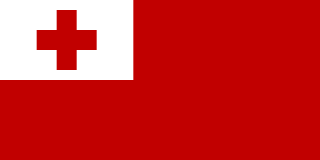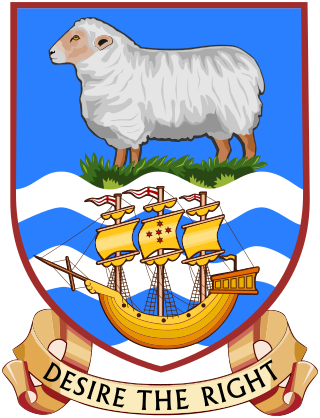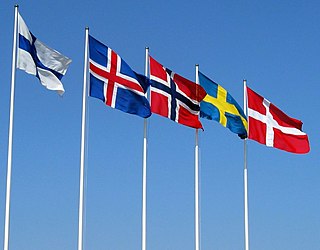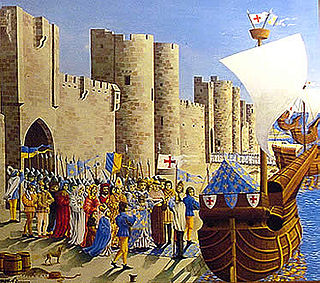
The national flag of Denmark is red with a white Nordic cross, which means that the cross extends to the edges of the flag and the vertical part of the cross is shifted to the hoist side.

A national flag is a flag that represents and symbolizes a given nation. It is flown by the government of that nation, but can also be flown by its citizens. A national flag is typically designed with specific meanings for its colours and symbols, which may also be used separately from the flag as a symbol of the nation. The design of a national flag is sometimes altered after the occurrence of important historical events. The burning or destruction of a national flag is a greatly symbolic act.

The national flag of Sweden consists of a yellow or gold Nordic cross on a field of light blue. The Nordic cross design traditionally represents Christianity. The design and colours of the Swedish flag are believed to have been inspired by the present coat of arms of Sweden of 1442, which is blue divided quarterly by a cross pattée of gold. Blue and yellow have been used as Swedish colours at least since Magnus III's royal coat of arms of 1275.

The Flag of Finland, also called siniristilippu, dates from the beginning of the 20th century. On a white background, it features a blue Nordic cross, which represents Christianity.

The national flag of Norway is red with a navy blue Scandinavian cross bordered in white that extends to the edges of the flag; the vertical part of the cross is shifted to the hoist side in the style of the Dannebrog, the flag of Denmark.

The national coat of arms of Armenia was adopted on April 19, 1992, by resolution of the Armenian Supreme Council. On June 15, 2006, the Armenian Parliament passed the law on the state coat of arms of Armenia.

The flag of Dominica was adopted on 3 November 1978, with some small changes having been made in 1981, 1988, and 1990. The original flag was designed by playwright Alwin Bully in early 1978 as the country prepared for independence.

The flag of the Dominican Republic represents the Dominican Republic and, together with the coat of arms and the national anthem, has the status of a national symbol. The blue on the flag stands for liberty, the white for salvation, and the red for the blood of heroes. The civil flag follows the same design, but without the charge in the center. The flag was designed by Juan Pablo Duarte.

The flag of Iceland was officially described in Law No. 34, set out on 17 June 1944, the day Iceland became a republic. The law is entitled "The Law of the National Flag of Icelanders and the State Arms" and describes the Icelandic flag as follows:

The flag of Tonga consists of a red field with a white canton charged with a red couped cross. Adopted in 1875 after being officially enshrined into the nation's constitution, it has been the flag of the Kingdom of Tonga since that year. The constitution stipulates that the national flag can never be changed.

The flag of the United States Virgin Islands was adopted on May 17, 1921. It consists of a simplified version of the coat of arms of the United States between the letters V and I. The yellow-colored eagle holds a sprig of laurel in one talon, which symbolizes victory, and three blue arrows in the other, which represent the three major islands that make up the U.S. Virgin Islands: Saint Croix, Saint Thomas, and Saint John. When the Virgin Islands were owned by Denmark, the flag was a blue ensign with the Danish flag, or Dannebrog, in the canton.

The Patriarchal cross is a variant of the Christian cross, the religious symbol of Christianity, and is also known as the Cross of Lorraine. Similar to the familiar Latin cross, the patriarchal cross possesses a smaller crossbar placed above the main one so that both crossbars are near the top. Sometimes the patriarchal cross has a short, slanted crosspiece near its foot. This slanted, lower crosspiece often appears in Byzantine Greek and Eastern European iconography, as well as in other Eastern Orthodox churches. In most renditions of the Cross of Lorraine, the horizontal bars are "graded" with the upper bar being the shorter, though variations with the bars of equal length are also seen.

The coat of arms of the Falkland Islands is the heraldic device consisting of a shield charged with a ram on tussock grass in a blue field at the top and a sailing ship on white and blue wavy lines underneath. Adopted in 1948, it has been the coat of arms of the Falkland Islands since 29 September of that year, except for the two-month occupation of the territory during the Falklands War in 1982. The escutcheon is featured on the flag of the territory. The ram represents the territory's past primary industry of sheep farming, while the ship symbolises the Desire which reportedly first sighted the islands at the end of the 16th century. The grass indicates the vegetation of the Falklands.

A Nordic cross flag is a flag bearing the design of the Nordic or Scandinavian cross, a cross symbol in a rectangular field, with the centre of the cross shifted towards the hoist.

The coat of arms of the Slovak Republic consists of a red (gules) shield, in early Gothic style, charged with a silver (argent) double cross standing on the middle peak of a dark blue mountain consisting of three peaks. Extremities of the cross are amplified, and its ends are concaved. The double cross is a symbol of its Christian faith and the hills represent three symbolic mountain ranges: Tatra, Fatra, and Matra.
Religion in national symbols can often be found in national anthems or flags. This has led to controversy in some secular states in regard to the separation of church and state, when the national symbol is officially sanctioned by a government.
The Russian Orthodox Cross is a variation of the Christian cross since the 16th century in Russia, although it bears some similarity to a cross with a bottom crossbeam slanted the other way (upwards) found since the 6th century in the Byzantine Empire. The Russian Orthodox cross has three horizontal crossbeams, with the lowest one slanted downwards. Today it is a symbol of the Russian Orthodox Church and a distinctive feature of the cultural landscape of Russia. Other names for the symbol include the Russian cross, and Slavonic or Suppedaneum cross.

The Christian cross, seen as a representation of the crucifixion of Jesus on a large wooden cross, is a symbol of Christianity. It is related to the crucifix and to the more general family of cross symbols, the term cross itself being detached from the original specifically Christian meaning in modern English.

The history of Christian flags encompasses the establishment of Christian states, the Crusader era, and the 20th century ecumenical movement.
















